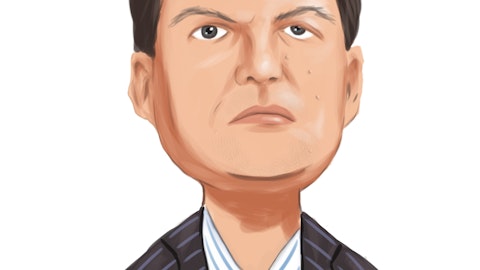Brandon King: So could you just give us some thoughts? So how you’re thinking about the level of deposits? You mentioned legacy PacWest customers are bringing the operating deposits back, but then you also have customers with excess liquidity. And I know you’re trying to manage the deposit costs pretty prudently. So if you could kind of give us a sense of how you think the level of deposits should trend as we go throughout the year.
Jared Wolff: Yes, it’s a good question. And what I focus on and historically have at Banc of California was on our level of non-interest bearing deposits along with our loan to deposit ratio. And so we’d like to maintain our loan to deposit ratio below 90%, preferably in the mid-80s, and we’ll see how that goes. And as we watch our non-interest bearing percentage rise, it gives us flexibility for other deposits that are of different types. So we have a whole bunch of initiatives in place here at Banc of California to grow our NIB, which is bringing over operating accounts from businesses, and we expect to grow from 26%. And eventually, over time, I’m not going to put a date on it, but we’ll get to 30% and we’ll get to 35% and eventually we’ll get to 40%.
That Banc of California legacy, we went from 12% to approximately 40% NIB. We have a roadmap to do this. And how we do it and the pace at which we do will dictate what happens with all these other deposits. We’re not going to ask customers to leave. We value our customers and the relationships we have. The one thing I will focus on, though, early and we’ve already started focusing on it, is concentration risk. And I think we’ve all learned that we have to live within our means and not become too reliant on any one customer on the loan or the deposit side. And so that’s something that we’re going to manage very carefully. We have tools to help our clients keep their relationship at the bank, but bring it off balance sheet so we’re not relying on it for lending.
We have asset management, a great team of people here that can help with corporate asset management, should we need it. And for some clients, that’s the right solution. And so, Brandon, there’s kind of a delicate balance of how we move all these things together. We did it at Banc of California historically. And so I would say that the things that we look at are the loan to deposit ratio and our percent of NIB and that provides the flexibility for everything else.
Brandon King: Got it. That makes sense. And then in your prepared remarks, you mentioned how you’re adding individuals and talent. Could you elaborate on that? What types of talent you’re adding? And how should we think about that as far as how it could impact expenses? I know you have a pretty tight range you’re expecting this year, but just going forward.
Jared Wolff: Yes. Well, there were some positions in some areas that we want to grow. We just added a talented leader to Head of Venture in California and lead our team here. We have – before we announced the acquisition, we brought in a new Head of Corporate Communications from City National, Deb Vrana, who’s doing a great job for us. We have a Head of Underwriting on the community bank side that we brought in recently. There is a whole host of talented leaders and players at all levels that we’re bringing in. We obviously are going to have to manage it within our expense targets. And getting down to that 2% OpEx ratio is going to require us to exercise some discipline, but we’re confident that we can do it.
Brandon King: Got it. And then just lastly, you gave us the spot yields, which is very helpful. Could you give us the spot yield on the securities portfolio?
Jared Wolff: Joe, do you have that?
Joe Kauder: You know I do. Just give me one second.
Jared Wolff: Okay, Brandon, we’ll take a look for that, Brandon.
Joe Kauder: No, I got it here, Jared, it’s 2.25%. I’m sorry, I read that wrong, 2.75%. I apologize. 2.75%.
Brandon King: Thank you very much. Very helpful. Thanks for taking my questions.
Joe Kauder: I couldn’t read my own handwriting.
Operator: Our next question comes from Gary Tenner from D.A. Davidson. Please go ahead with your question.
Gary Tenner: Thanks. Good morning.
Jared Wolff: Good morning.
Gary Tenner: A couple of questions. One, the NIM guide of approaching 3%, just confirming that’s inclusive of the expected loan discount accretion that you kind of lay out on an annualized basis in the slide deck.
Joe Kauder: Yes, yes.
Gary Tenner: Okay. All right. Full guide number. Okay. And Jared, you kind of answered part of this with your comment around the BTFP and repaying that probably before the end of the quarter. But in the deck it kind of one of your checklist items was to complete restructuring the balance sheet. Now, I know there’s going to be kind of ongoing, obviously, for some period of time, kind of optimizing of the balance sheet. But just wanted to get a sense of any kind of clear discrete items outside the BTFP repayment that are still planned for the first quarter?
Jared Wolff: Well, I think it’s expense reductions. There are pieces of the discontinued loan portfolios that capital permitting we might look to sell. If we think the yield is so low that we can – it’s somewhat of a negative carry relative to other funding that we could pay off. We’re constantly looking at that and looking at what the pricing is, and pricing is kind of moving around in the market as people settle in on, on where they think rates are going to be. So we’re not ignoring that there are other things that we could sell. We just haven’t made the decision to definitely sell those things, absent one or two things. So I think that’s something that you could expect, Gary. Look, there’s a lot of – these are somewhat unclear times from an economic standpoint, and I think a lot of banks are looking at the road ahead and it’s kind of filled with debris and they’re trying to figure out how they’re going to drive down the road and kind of get to the end zone.




